What Is the Taiga?
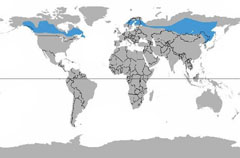 The taiga (ty-ga) is the largest land biome. It stretches across a large part of Canada, Asia and Europe and can be found between the tundra and deciduous forests. The taiga (ty-ga) is the largest land biome. It stretches across a large part of Canada, Asia and Europe and can be found between the tundra and deciduous forests.
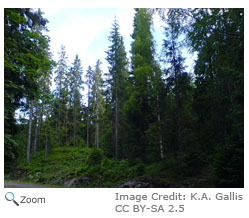 Winters in the taiga are cold and the
summers are warm. The taiga gets between 15 and 30 inches of precipitation
a year. In the summer, temperatures can reach the 70s. In the winter,
temperatures can be as cold as 65 degrees below zero! The taiga is sometimes
called the coniferous or boreal forest.
Coniferous forests are found
in northern Canada, Asia, and Europe. Coniferous forests are also found at high altitudes in the United States. In New Hampshire, coniferous forests are found in the White Mountains. Winters in the taiga are cold and the
summers are warm. The taiga gets between 15 and 30 inches of precipitation
a year. In the summer, temperatures can reach the 70s. In the winter,
temperatures can be as cold as 65 degrees below zero! The taiga is sometimes
called the coniferous or boreal forest.
Coniferous forests are found
in northern Canada, Asia, and Europe. Coniferous forests are also found at high altitudes in the United States. In New Hampshire, coniferous forests are found in the White Mountains.
Ready for Snow!
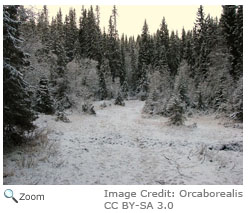 Coniferous trees like spruce, hemlock, pine and fir are commonly found in the taiga. Most coniferous trees are evergreen and are specially adapted to survive in this biome. Evergreen trees are cone-shaped to help snow slide off them so the branches won't break. The leaves or needles of evergreen trees lose less water than other kinds of leaves. This also helps them survive. Some broad-leaved trees like birch and aspen have adapted to the taiga, too. Both trees are very flexible and don't break easily when covered with ice and snow! Coniferous trees like spruce, hemlock, pine and fir are commonly found in the taiga. Most coniferous trees are evergreen and are specially adapted to survive in this biome. Evergreen trees are cone-shaped to help snow slide off them so the branches won't break. The leaves or needles of evergreen trees lose less water than other kinds of leaves. This also helps them survive. Some broad-leaved trees like birch and aspen have adapted to the taiga, too. Both trees are very flexible and don't break easily when covered with ice and snow!
|
|
Living
in the Taiga
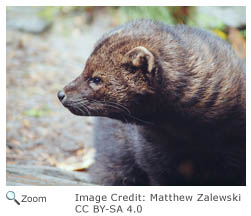 There are many animals that make the taiga their home. Many birds breed in the taiga in the spring and summer. As the snow melts in the spring, insects lay their eggs in the water. The insects attract a wide variety of species of birds to the taiga like the spruce grouse. In North America, mammals like pine martens, moose, wolves, fisher, Canada lynx, and grizzly bears are all found in the taiga. These mammals all have thick coats that protect them from the cold. There are many animals that make the taiga their home. Many birds breed in the taiga in the spring and summer. As the snow melts in the spring, insects lay their eggs in the water. The insects attract a wide variety of species of birds to the taiga like the spruce grouse. In North America, mammals like pine martens, moose, wolves, fisher, Canada lynx, and grizzly bears are all found in the taiga. These mammals all have thick coats that protect them from the cold.
Adapted for the Taiga
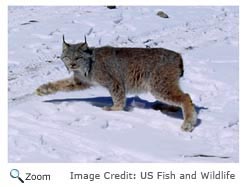 Some animals have structural adaptations that help them survive in the taiga. The Canada lynx's wide paws work like snowshoes. They distribute the lynx's weight, and help it move in the snow. Grizzly bears avoid the coldest weather by going into their dens in the fall and staying there until the early spring. They have a protective layer of fat that allows them to stay in their dens while the weather is cold. They don't hibernate but just sleep lightly and stay out of the cold! Some animals have structural adaptations that help them survive in the taiga. The Canada lynx's wide paws work like snowshoes. They distribute the lynx's weight, and help it move in the snow. Grizzly bears avoid the coldest weather by going into their dens in the fall and staying there until the early spring. They have a protective layer of fat that allows them to stay in their dens while the weather is cold. They don't hibernate but just sleep lightly and stay out of the cold!
|